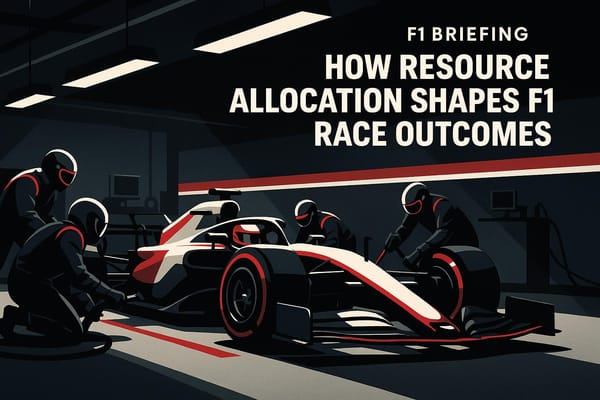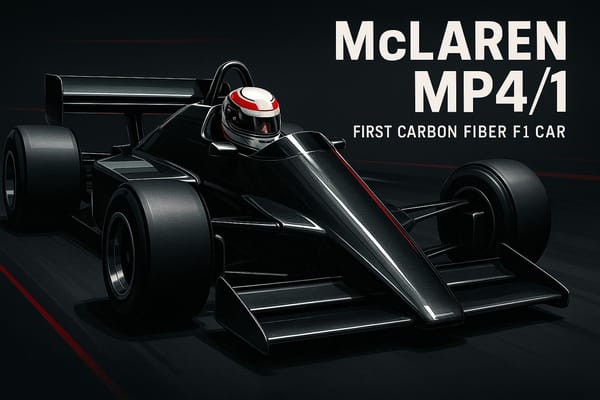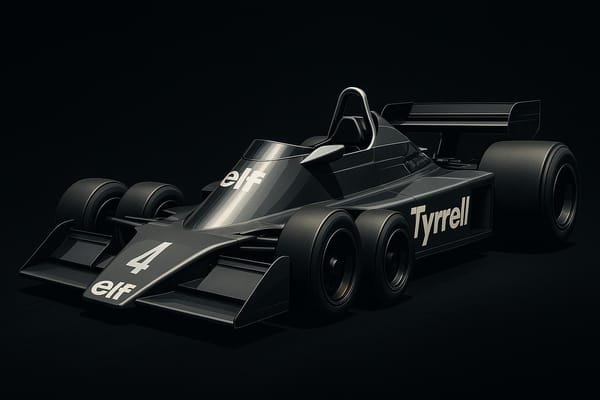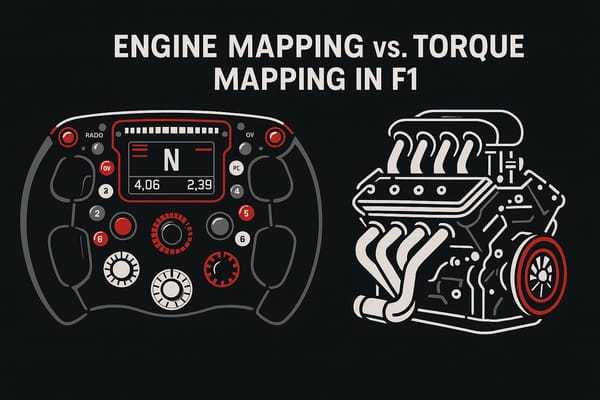How F1 Pit Crews Train for 2-Second Stops
Explore the rigorous training, techniques, and teamwork that enable F1 pit crews to achieve lightning-fast pit stops in under two seconds.
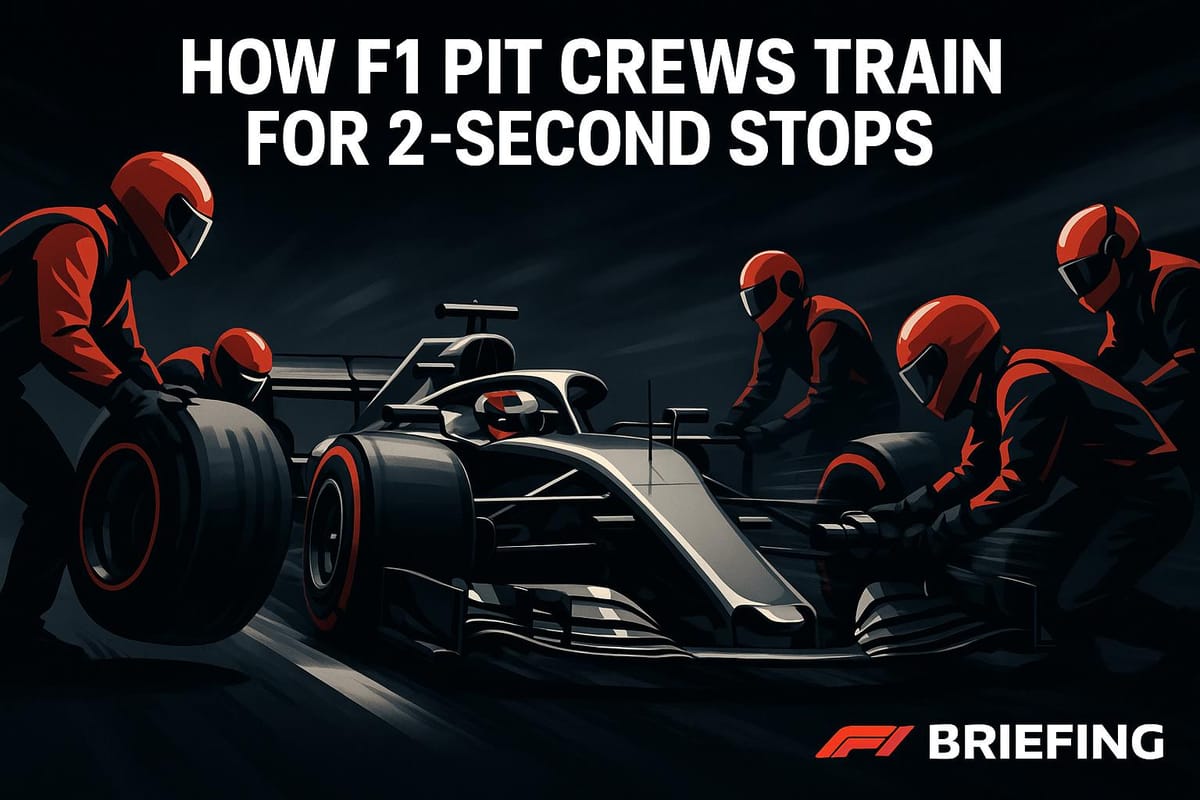
Did you know? The fastest Formula 1 pit stop ever recorded was just 1.80 seconds by McLaren in 2023.
Here’s how pit crews pull off these near-instant stops:
- Intense Training: Crews practice over 1,000 pit stops per season to perfect their timing and precision.
- Physical Fitness: Each role has tailored workouts - jackmen focus on explosive strength, while wheel gun operators train hand-eye coordination.
- Emergency Drills: Teams rehearse handling equipment failures, fire hazards, and other race-day surprises.
- Data Analysis: High-speed cameras and telemetry track every millisecond to refine performance.
- Mental Preparation: Visualization and stress management help crews stay focused under pressure.
In F1, a pit stop isn’t just a tire change - it’s a choreographed feat of teamwork, speed, and precision that can decide the outcome of a race.
What it takes to be part of our #F1 pit stop crew?
Physical Fitness: Building Strength, Speed, and Endurance
F1 pit crew members endure grueling physical demands. During race weekends, they often work 12–16 hour days, tirelessly building and maintaining cars in sweltering conditions, all while executing pit stops that can make or break a race.
Over the course of a season, pit crews perform around 1,000 pit stops, most of which are practice runs. This relentless schedule pushes them to their limits, with fatigue, jet lag, and the pressure of avoiding costly mistakes constantly looming. By the season's end, medical supply usage among crew members rises by 20–25%, a stark reminder of the toll this work takes.
"The demands on a pit crew member on a race week are 95% about being good at your primary job, handling the stressful work environment, building the car effectively and fixing faults. Maybe 5% of your time is pit stop focused."
– Paul Walker, Performance Coach at Hintsa
Pit stops themselves are a high-stakes challenge. Crew members must shift from precise, methodical tasks to rapid, adrenaline-fueled action in seconds. For instance, wheel gun operators experience significant spikes in heart rate as they sprint into position and execute their tasks under immense pressure.
"Your heart is pretty much racing by this point already from the run out, let alone the adrenaline and the nerves."
– Callum Adams, Red Bull wheel gun operator
Fitness Programs for Each Role
Each crew role comes with unique physical demands, and training programs are tailored to meet those needs.
Jackmen rely on exceptional core strength and explosive power to lift cars weighing approximately 1,650 pounds. Their training includes deadlifts, squats, and plyometric drills, which help develop the fast-twitch muscle fibers needed for quick, powerful lifts. Cardiovascular endurance is also critical to sustain their performance during long practice sessions.
Wheel gun operators focus on hand–eye coordination and upper body strength. Their workouts emphasize grip strength, shoulder stability, and reaction time. Teams like Aston Martin even use reaction drills with tennis balls to sharpen their timing and precision, skills that are crucial for their role.
Tire carriers need to handle heavy wheels with speed and agility. Their fitness routines combine functional strength training with agility drills, targeting the twisting, lifting, and quick directional movements required during pit stops.
"To get the best performance from each member of the team, training must be relevant to the individual and their role. Their training is therefore tailored to the individual and their position-specific needs."
– Dr. Rahul Chotai, Team Doctor, Aston Martin Aramco F1 Team
Teams also employ fitness coaches to monitor individual progress and ensure that each crew member meets their specific goals. The pre-season period is crucial for building strength, while mid-season training focuses on maintaining fitness and preventing injuries amidst constant travel and changing environments.
Injury Prevention and Recovery
Preventing injuries is a top priority, given the intense and repetitive nature of pit crew tasks. Teams have implemented extensive measures that go beyond basic warm-ups.
Pre-session preparation plays a vital role. For example, Aston Martin utilizes mobility and stretching exercises to improve flexibility and reduce the risk of injuries.
"We use various mobility and stretching exercises to prepare the mechanics and increase their flexibility ahead of a session and also to prevent injuries."
– Dr. Rahul Chotai, Team Doctor, Aston Martin Aramco F1 Team
Many teams travel with doctors and physiotherapists, ensuring immediate medical support at every race. These professionals not only treat injuries but also monitor pit stop practices to identify potential issues early. Health tracking tools, such as blood pressure readings, performance tests, and blood analyses, help teams recognize when a crew member is nearing their physical limits.
Environmental factors add another layer of complexity. In hot climates like Singapore, hydration is critical. Crew members may consume three to five liters (0.8 to 1.3 gallons) of fluids on particularly hot days. Cooling strategies are also employed to regulate body temperature and avoid heat-related problems.
Recovery extends well beyond the track. Adjustments to sleep schedules, meal timings, and training plans help combat jet lag and keep crew members sharp despite frequent time-zone changes. During flyaway races, nutritional supplements become essential for maintaining immunity and speeding up recovery between sessions.
"Maintaining people's energy levels over the course of a season is not as trivial as it might seem."
– Mercedes-AMG PETRONAS F1 Team
Technical Drills: Perfecting the Process
In Formula 1, a split second can make or break a race. Achieving a sub-two-second pit stop - an extraordinary feat - is the result of countless hours of technical practice, where every move is fine-tuned for precision and efficiency.
Unlike physical training, technical drills focus entirely on the choreography of the pit stop. Each team member has a clearly defined role, and success depends on flawless coordination among the crew. This level of synchronization is built through repetitive, structured routines.
Teams use a data-driven approach to perfect their pit stops. During race weekends, practice sessions are scheduled daily, typically lasting 30 minutes and involving around 50 stops per session. However, the real groundwork is laid during the off-season and between races, when crews can focus on refining their techniques without the pressure of an upcoming competition.
Repetition and Muscle Memory
Consistency in pit stops is achieved through relentless repetition. For example, Williams performed over 1,200 practice pit stops on a rig before the 2019 season, highlighting the sheer volume of practice required to operate at the sport's highest level.
"We spend most of January and February on the rig, trying to hone into who we think is the best combination. And then we obviously work on it through the year."
– Dave Redding, Williams Team Manager
The practice rig is a cornerstone of training, offering a controlled environment for unlimited repetitions without interference from track conditions or weather. Crews analyze every step of the pit stop to perfect individual tasks before combining them into a seamless sequence. For instance, wheel gun operators must master the exact angle and pressure needed to engage their tools, which spin at over 10,000 revolutions per minute. A slight error in positioning can waste valuable time or result in a cross-threaded wheel nut.
Beyond individual roles, the choreography extends to the entire crew. Tire carriers must approach in sync to avoid collisions with jackmen, while wheel gun operators position themselves with millisecond precision. Teams meticulously analyze every fraction of a second to uncover areas for improvement. This rigorous repetition not only sharpens routine execution but also equips the crew to handle unexpected challenges.
Practicing Emergency Scenarios
Once crews have perfected their routines, they turn their attention to handling emergencies. While a standard pit stop follows a predictable pattern, races often throw curveballs that test a crew’s ability to adapt under pressure. Equipment malfunctions, such as wheel gun failures, hydraulic jack issues, or damaged wheel nuts, are common scenarios crews must prepare for. Teams practice activating backup tools or alternative procedures to maintain efficiency.
One of the trickiest situations is cross-threading, where a wheel nut is improperly engaged. Crews drill on identifying the problem instantly and responding appropriately, whether by switching to a spare wheel or adjusting the tightening sequence.
"Regular training and drills, whether a mass casualty simulation or a high-fidelity resuscitation scenario, build the muscle memory responders need when chaos strikes."
– Rob Lawrence, MCMI
Fire and safety emergencies demand an entirely different set of protocols. Situations like engine fires or malfunctions require crews to practice evacuating the pit box, deploying fire suppression equipment, and coordinating with track safety officials. These drills ensure the safety of both drivers and crew while allowing the race to continue. Teams also simulate communication breakdowns, practicing the use of visual signals and backup methods to ensure the pit stop can proceed smoothly, even without primary communication channels.
Track-specific challenges further complicate emergency preparation. As Dave Redding explains:
"When we get to the track, most of what we do is what is unique about the track... so we need to adjust to the features of the pit lane."
– Dave Redding, Williams Team Manager
Some circuits feature narrow pit lanes, tricky entry or exit angles, or unique safety requirements that can disrupt standard procedures. By tailoring their emergency responses to these conditions, crews stay prepared for anything.
Through relentless practice and emergency simulations, every technical drill reinforces the precision, adaptability, and teamwork required for championship-winning pit stops.
Data Analysis: Using Technology to Improve Performance
Formula 1 pit stops generate an extraordinary amount of data. Each car produces approximately 1.1 million telemetry points every second, with teams collecting around 400 GB of data per race. This massive influx of information allows teams to scrutinize every detail of their pit stop performance, identifying inefficiencies that might otherwise remain hidden. The shift from manual analysis to automated, data-driven systems has completely transformed how teams refine their strategies and execution.
Video Analysis and Motion Tracking
High-speed cameras capture every movement during a pit stop. When paired with telemetry data, these recordings provide a detailed breakdown of crew performance. Scuderia Ferrari HP, in collaboration with AWS, has taken this a step further with a machine learning solution. Using Amazon SageMaker AI, this system employs object detection to automatically identify critical moments - like when the green light signals the car to leave - and synchronizes video footage with telemetry data. Marco Gaudino, Digital Transformation Racing Application Architect, explained:
"Previously, manual analysis of video recordings and telemetry data risked missing critical details; the new machine learning solution automates this, synchronizing video with telemetry immediately".
This system was tested at the March 2024 Australian Grand Prix and fully implemented by the 2024 Japanese Grand Prix. The result? Data correlation times dropped to just 60–90 seconds, helping Scuderia Ferrari achieve a season-best 2.0-second pit stop for Charles Leclerc in Saudi Arabia.
Motion tracking further enhances performance by analyzing the coordination of each crew member. For instance, wheel gun operators can refine their positioning to reduce engagement time, while tire carriers can adjust their movements to minimize collisions. Clare Williams, deputy team principal of Williams, highlighted the importance of this approach:
"We use slow-motion video analysis to improve our pit stops".
This meticulous analysis can pinpoint subtle delays - like a tire carrier hesitating for just a fraction of a second - that are critical in a sport where the fastest pit stops, such as a 1.82-second benchmark, set the standard.
While video analysis provides a visual breakdown of performance, telemetry data quantifies the timing and uncovers additional opportunities to save precious milliseconds.
Telemetry and Performance Metrics
Telemetry plays a central role in pit stop analysis by tracking split times, from the car's arrival to its departure, and identifying specific areas for improvement. When combined with video analysis, teams gain a complete picture of their performance, enabling more precise optimizations.
Teams also factor in contextual data like tire wear, fuel consumption, and the positions of competitors. A notable example occurred during the 2019 British Grand Prix, when Mercedes used such metrics to plan Lewis Hamilton’s pit stop. By timing his stop perfectly during a safety car period, Hamilton secured a decisive victory.
Oracle Red Bull Racing has also embraced data-driven strategies. Using Oracle Cloud, the team refines race strategies, engine development, simulation racing, and even fan engagement. Christian Horner, CEO of Oracle Red Bull Racing, underscored the importance of this approach:
"Data is in the team's lifeblood. Every element of performance - how we run a race, how we develop a car, how we select and analyze drivers - it's all driven by data".
Beyond just timing, teams monitor consistency and reliability, striving to reduce variability in their execution. In the high-pressure world of Formula 1, even the smallest improvements in consistency can mean the difference between winning and losing.
Mental Preparation: Staying Focused Under Pressure
While data analysis provides the technical backbone for flawless pit stops, the mental aspect is just as crucial. In Formula 1, where every fraction of a second counts, pit crews undergo rigorous training to sharpen both their physical and mental skills. The mental challenges they face are comparable to those of the drivers, who must juggle multiple tasks while staying laser-focused under immense pressure.
Psychological preparation is deeply tied to teamwork. Crew members must maintain their cool while executing precise, synchronized routines in high-pressure, confined environments. Their training includes mindfulness, stress management, decision-making, resilience, and spatial awareness.
Visualization and Stress Management
Visualization is a cornerstone of mental preparation. It involves mentally rehearsing each step of the pit stop, from the car's arrival in the pit box to its exit. For pit crews, this means breaking down tasks into smaller, process-oriented steps - like the wheel gun operator perfecting their accuracy or the tire carrier refining their approach angle.
Mark Arnall, an F1 performance coach, highlighted how effective visualization can be:
"I used to use a form of this with Mika Hakkinen before qualifying, for example, to visualize the perfect lap [and] mentally run through it over and over. It worked very well".
This same technique is invaluable for pit crews. Dr. Wood explains:
"This can be particularly important when time for physical practice is limited, as is often the case for Formula 1".
Breathwork complements visualization by helping crew members manage stress and stay focused during high-pressure moments, like the seconds leading up to a pit stop. These methods are especially useful when unexpected challenges arise.
Another key aspect of mental training is self-awareness. By identifying and addressing counterproductive habits, crew members can prevent these from affecting their performance. British F1 driver George Russell puts it well:
"Formula 1, for us drivers, is as much about mental health as physical health".
This individual mental discipline sets the stage for seamless team communication during the high-stakes environment of a pit stop.
Team Communication and Coordination
Once individual mental skills are honed, the focus shifts to team communication. Clear communication protocols are essential during pit stops, ensuring every team member knows their role and reducing the chance of mistakes. Teams rely on specific verbal and visual signals designed to cut through the chaos of a live pit lane.
This coordination extends beyond the pit crew to include the driver and support team. Pre-defined radio signals and gestures ensure that everyone - from the driver to the tire changers - operates in perfect sync, whether it’s a routine tire change or an emergency repair.
Trust is the glue that holds pit stop operations together. Antti Kontsas, Head of Performance for Motorsport at Hintsa, underscores this:
"The driver must have well-defined process goals that he can control for each session and the weekend as a whole... These goals offer a reference point to rely on when stress increases, allowing the driver to quickly refocus".
For pit crews, trust is built through repeated practice. By rehearsing key procedures until they become second nature, teams can respond instinctively - even when faced with unexpected setbacks like a dropped wheel nut or a miscommunication. This preparation boosts confidence and adaptability under pressure.
Red Bull’s Sergio Pérez sums it up perfectly:
"Put your energy in things you can control".
Encouragement and constructive feedback further strengthen the mental resilience of pit crews, enabling them to perform at their peak even when the stakes are sky-high.
Off-Season Training and Skill Development
For Formula 1 pit crews, the off-season isn’t a time to relax completely - it’s a chance to recharge and sharpen their skills for the grueling challenges ahead. Unlike other sports where a break might mean downtime, F1 pit crews use this period with the same level of focus and strategy they bring to race day.
Charlie Hooper, McLaren's Operations Director, sheds light on how teams approach this critical time:
"Through the off-season, we spend the time just like any professional sports team would... We are continually evolving how we approach the winter break to see how it best suits both how pit stop regulations have changed and how the racing calendar looks. The working group in charge of pit stops set out the targets for the 2025 pre-season before the 2024 season had even finished."
This proactive mindset ensures teams hit the ground running when the season begins. The off-season isn’t an afterthought - it’s a deliberate phase for selecting the pit crew lineup, testing new equipment, and practicing pit stops intensively. These preparations lay the groundwork for the demanding in-season schedule.
Pre-Season Programs and New Equipment
The transition from off-season to pre-season is seamless but intense. Starting in January, pit crews dive into a rigorous training phase designed to perfect the physical and technical precision needed for sub-2-second pit stops.
Hooper elaborates on this preparation:
"The team will have training sessions and pit stops every day over the pre‑season starting in January building up the squad to enable us to put the strongest team out at each event."
This daily grind reflects the high stakes of modern F1 pit stops, where every fraction of a second counts. Physical training combines strength-building exercises with technical drills. At McLaren, this happens at the Optimum Nutrition McLaren Performance Hub, where the Strength & Conditioning team focuses on more than just strength. As Hooper notes, the goal is also to build resilience for the long season and the physical toll of pit stops.
This preparation is vital because the season spans nearly nine months and 23 races. Teams monitor fitness levels through detailed assessments, including blood tests and physical evaluations, tailoring individual training plans to each crew member.
On the technical side, pre-season training emphasizes adapting to new equipment and regulations. With each season introducing changes, crews must tweak their techniques, timing, and coordination. Teams dedicate significant time to testing tools, practicing new procedures, and ensuring every crew member understands their role amid evolving rules.
To avoid burnout before the season even begins, training intensity is carefully managed. Experts recommend keeping fatigue levels below 25% during pre-season to ensure crew members are fresh and ready for the first race weekend.
Managing Training During Travel and Race Schedules
Once the season kicks off, balancing training with the demands of travel and race weekends becomes a new challenge. The packed F1 calendar, with its back-to-back races across the globe, requires precise planning to maintain peak performance.
Fatigue management becomes a top priority. Teams keep a close eye on crew members’ fatigue levels, ensuring they stay below critical thresholds on race days. To achieve this, training sessions are strategically scheduled around travel and race commitments.
One effective strategy involves front-loading workouts early in the week. This approach allows crew members to recover and focus as the race weekend nears. Double gym sessions have also proven useful for improving pit stop times, but these must be timed carefully to avoid affecting performance during race weekends. Longer breaks between races or dedicated training camps at home facilities often provide opportunities for these more intense sessions.
The constant travel demands of Formula 1 call for creative solutions. Teams bring portable training equipment on the road, ensuring crew members can stick to their fitness routines no matter where they are.
Rest and recovery are just as vital as training. Scheduled rest days are built into the calendar to prevent fatigue from piling up over the season. These breaks are essential for maintaining the precision and stamina required for flawless pit stops. By balancing training, recovery, and travel, teams ensure that the skills honed in the off-season remain sharp throughout the racing year.
Conclusion: Precision, Teamwork, and Constant Improvement
Every element of an F1 pit stop - whether physical, technical, or mental - showcases an unwavering drive for perfection. The quest for the ultimate pit stop is one of Formula 1's most captivating examples of human performance. McLaren's 1.80-second world record at the 2023 Qatar Grand Prix wasn’t just a moment of brilliance; it was the culmination of countless hours of rigorous preparation.
These lightning-quick stops are only possible through the flawless coordination of physical strength, technical accuracy, and mental focus. With over 20 crew members involved, each individual must perform their task with absolute precision under immense pressure.
But strength alone doesn’t guarantee success. Mental toughness is just as critical, as even the smallest mistake can cost a team valuable track positions. To combat this, pit crews rely on hundreds of practice stops each season, embedding the muscle memory needed for perfect execution. As Michael Luzich aptly puts it:
"The science of pit stops is a blend of engineering, teamwork, and split-second decision-making".
What sets the elite teams apart is their dedication to constant improvement. They don’t just practice - they analyze. Every pit stop is dissected through video reviews and performance metrics, with every movement scrutinized to find areas for refinement. This relentless pursuit of betterment is the foundation of race-winning performances.
Teams capable of delivering sub-2-second pit stops know that every millisecond matters. In a sport where championships are often decided by the narrowest margins, even the smallest gains can make the difference. As highlighted in their rigorous drills and training, this commitment to precision and teamwork continues to push the boundaries of what's possible in Formula 1.
The modern F1 pit stop is the ultimate example of precision, collaboration, and the drive for constant progress. It’s a powerful reminder that in Formula 1, success isn’t just about the driver - it’s about the entire team coming together in those critical moments when races are won or lost.
FAQs
How do F1 pit crews stay physically and mentally sharp during a demanding season?
F1 pit crews achieve top-notch physical and mental performance through rigorous training routines tailored to their demanding roles. These routines typically involve strength training, cardio exercises, and team-focused drills, all aimed at ensuring flawless coordination and precision during the intense moments of a pit stop.
To maintain mental acuity, they incorporate mindfulness practices and simulate race-day scenarios, sharpening their ability to make split-second decisions under pressure. This blend of physical conditioning and mental preparation allows pit crews to execute lightning-fast stops with remarkable consistency throughout the racing season.
What does each member of an F1 pit crew do during a pit stop?
During an F1 pit stop, every crew member performs a specific task with precision, all aimed at completing the process in under two seconds. Tire changers and wheel carriers seamlessly work together to swap out tires, while jack operators lift the car from the front and rear. Meanwhile, other crew members focus on aerodynamic tweaks, minor repairs, or wing adjustments to enhance the car's performance.
This level of efficiency isn't accidental - it’s the result of intense training and countless rehearsals. Every fraction of a second counts, and the entire team must operate in perfect harmony, as even the slightest misstep can affect the outcome of the race.
How does data analysis help F1 teams achieve faster and more efficient pit stops?
The Role of Data Analysis in F1 Pit Stops
In Formula One, data analysis is a game-changer when it comes to perfecting pit stops. Teams rely on cutting-edge tools like infrared sensors, AI-driven systems, and real-time analytics to fine-tune every aspect of the process. These technologies help pinpoint inefficiencies, enhance crew coordination, and streamline each team member's movements down to the smallest detail.
By studying historical data and using predictive models, teams can also decide the ideal moment for a pit stop, minimizing time lost on the track while boosting overall race performance. Paired with relentless practice and precision drills, these insights enable teams to consistently deliver pit stops in under two seconds. In a sport where every millisecond counts, that kind of speed can be the difference between winning and losing.

